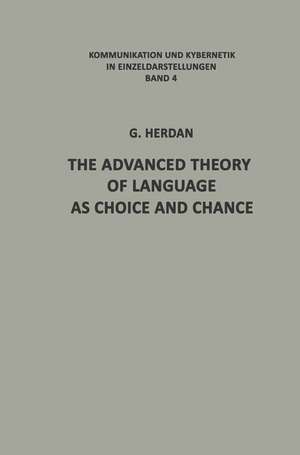The Advanced Theory of Language as Choice and Chance: Communication and Cybernetics, cartea 4
Autor Gustav Herdanen Limba Engleză Paperback – 7 iul 2012
Din seria Communication and Cybernetics
-
 Preț: 437.72 lei
Preț: 437.72 lei - 20%
 Preț: 645.31 lei
Preț: 645.31 lei - 15%
 Preț: 646.62 lei
Preț: 646.62 lei - 15%
 Preț: 642.83 lei
Preț: 642.83 lei -
 Preț: 379.86 lei
Preț: 379.86 lei - 15%
 Preț: 642.03 lei
Preț: 642.03 lei - 15%
 Preț: 639.41 lei
Preț: 639.41 lei -
 Preț: 489.87 lei
Preț: 489.87 lei -
 Preț: 383.71 lei
Preț: 383.71 lei -
 Preț: 383.93 lei
Preț: 383.93 lei -
 Preț: 397.59 lei
Preț: 397.59 lei -
 Preț: 410.94 lei
Preț: 410.94 lei - 20%
 Preț: 360.05 lei
Preț: 360.05 lei -
 Preț: 383.71 lei
Preț: 383.71 lei - 15%
 Preț: 647.08 lei
Preț: 647.08 lei - 15%
 Preț: 634.18 lei
Preț: 634.18 lei
Preț: 398.74 lei
Nou
Puncte Express: 598
Preț estimativ în valută:
76.30€ • 79.86$ • 63.50£
76.30€ • 79.86$ • 63.50£
Carte tipărită la comandă
Livrare economică 31 martie-14 aprilie
Preluare comenzi: 021 569.72.76
Specificații
ISBN-13: 9783642883903
ISBN-10: 3642883907
Pagini: 480
Ilustrații: XV, 459 p. 6 illus.
Dimensiuni: 155 x 235 x 25 mm
Greutate: 0.67 kg
Ediția:Softcover reprint of the original 1st ed. 1966
Editura: Springer Berlin, Heidelberg
Colecția Springer
Seria Communication and Cybernetics
Locul publicării:Berlin, Heidelberg, Germany
ISBN-10: 3642883907
Pagini: 480
Ilustrații: XV, 459 p. 6 illus.
Dimensiuni: 155 x 235 x 25 mm
Greutate: 0.67 kg
Ediția:Softcover reprint of the original 1st ed. 1966
Editura: Springer Berlin, Heidelberg
Colecția Springer
Seria Communication and Cybernetics
Locul publicării:Berlin, Heidelberg, Germany
Public țintă
ResearchCuprins
1. Introduction.- 1.1. Historical sketch.- 1.2. Language as a mass phenomenon — ‘Quantity Survey’ of language.- 1.3. Chance as a factor of linguistic expression and language structure.- 1.4. Structuralism and statistical linguistics.- 1.5. Language as choice and chance.- 1.6. De Saussure’s ‘Principe Linéaire’ and geometrical duality.- 1.7. Literary statistics, a new branch of applied statistics.- 1.8. Plan of the book.- I. Language as Chance I — Statistical Linguistics.- 2. Stability of Linguistic Distributions.- 3. Explanation of Stability of Linguistic Distributions.- 4. Application of the Theory of Stability of Alphabetic Distributions to a Problem of Language Mixture.- II. Language as Choice I — Stylostatistics.- 5. Style as a Statistical Concept.- 6. Word Count Mathematics.- 7. Style Relationships — Bi-Variate Stylostatistics.- 8. A Guide to Stylo-statistical Investigations.- III. Language as Chance II — Optimal Systems of Language Structure.- III.(A) Combinatorics on the Phonemic (Alphabetic) Level.- 9. The Combinatorial Structure of Words.- 10. Optimality of the Word-Length Distribution.- 11. Combinatorics applied to Problems of Classical Poetry.- III.(B) Combinatorics on the Lexicon Level.- 12. Random Partitioning of Vocabulary — Vocabulary Connectivity.- 13. The Generalised Random Partitioning Function and Stylostatistics.- 14. The “New Statistics” on the Vocabulary Level.- III.(C) Information Theory.- 15. Principles of Information Theory.- 16. Information-Theoretical Analysis as a Tool of Linguistic Research.- 17. Language Translations as Bi-Variate Distributions of Coding Symbols.- IV. Language as Choice II — Linguistic Duality.- 18. The Four-fold Root of Linguistic Duality.- 19. Duality as Correcting Factor — Inadequacy ofTruly SeiologicCodes.- 20. Duality and Language Translation.- V. Statistics for the Language Seminary.- V.(A) Statistics of Language in the Mass.- 21. Descriptive Statistics.- 22. Statistical Inference — The Binomial Case.- 23. Statistical Inference in the Case of Multiple Classification of Events.- 24. Theory of Correlation.- V. (B) Statistics of Language in the Line.- 25. The Dimension of Time in Language Statistics.- 26. Linguistic Duality and ‘Parity’.- Appendix — A Survey of Past and Present-day Statistical Linguistics.- Author Index.












